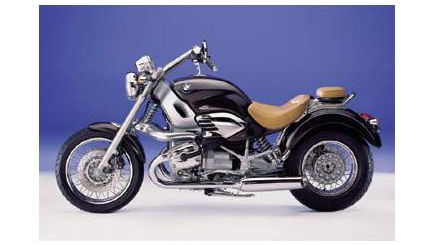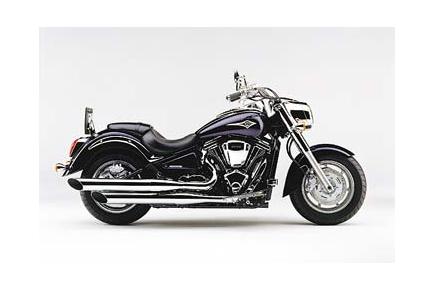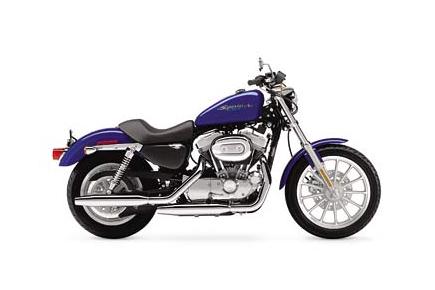R1200C Classic review
If you really want a BMW cruiser, try the Montauk

BMW 2003 Press Kit: When the R1200C cruiser was introduced in 1997 it flouted convention.
BMW had taken an alternative motorcycling concept and refined it. The sophisticated, high-tech machine owed little to anything that had preceded it – there was nothing pseudo-American about its design or inspiration. The R1200 C was unmistakably BMW and it showed in every original line and high quality component. Cruising had entered a new era.
Within two years of its launch, the BMW R1200 C had been voted “Motorcycle of the Year”, or “Cruiser of the Year” in many countries. The ultimate accolade came when the makers of the James Bond movie series – renowned for their love of high-tech, modern products and innovative design – selected the bike for 007 to ride in the film, Tomorrow Never Dies. The bike was as spectacular as the action.
Note: there are three variants of the R1200 C – the £8,695 Classic, the £8,795 Avantgarde and the £8,995 Independent. The description below is common to all three models but refers specifically to the Classic, which is the base model. The differences are listed as an addendum at the end of this media release.
Chromium-plated power
A specially tuned and chrome-finished version of BMW’s modern, but timeless, four-valve horizontal twin not only smashed tradition, it proved that a cruiser didn’t have to conform to old-fashioned concepts. The 1170cc, boxer engine is designed to produce more torque at low speed rather than maximum power. Finished expansively in high quality chrome, the big twin delivers 61 bhp at 5,000 rpm, but equally important is that it produces 70 lb ft of torque (98 Nm) at 3,000 rpm. This translates as superlative throttle control and excellent response when negotiating city traffic. In addition, less gear changing is required.
All three models of the R1200 C are equipped with a closed-loop, three-way catalytic converter.
The Motronic engine management system has been re-programmed to make significant improvements to the original control concept (MA 2.4) so that it now optimises torque at low engine speeds. This means that the maximum possible is produced.
The R1200 C’s copious torque is fed to the rear wheel through a five-speed gearbox, with dedicated ratios, and BMW’s proven drive shaft – now situated in the hollow swinging arm (of the Monolever). It features not only two universal joints, but also a torsion damper. The single-plate dry clutch is hydraulically operated.
On the open road, the low-stressed, low-revving engine gives the impression that it is unbreakable. Cruising has never been as easy. The power unit is so independent of high engine speeds that a revs counter is not necessary.
Road-holding means holding the road
For a cruiser, road-holding has always been more important than handling. BMW motorcycles hold the road and maintain a line over bad surfaces better than other contemporary machines. It is a quality that is accepted and expected by BMW users and a tradition that continues with the R1200 C.
Contributing factors that continue to maintain BMW’s reputation for excellent road-holding and handling include the famous Telelever front suspension and Paralever-enhanced swinging arm which is mounted on the frame instead of the gearbox. The R1200 C has a much longer swinging arm, called the Monolever, than other modern BMWs. Because of its length, the Monolever does an efficient job of damping torque reaction from the drive shaft equally as well as the Paralever (which is a more complex double-joint swinging arm).
Wheels are always crucial to the character of a motorcycle, particularly a cruiser. On two of the R1200 C models (Classic and Avantgarde) high-gloss chrome, cross-spoke wheels are a fitted as standard. BMW has not re-invented the wheel, but the model used on the two cruisers is a particularly stable structure where a self-contained rim base allows the fitting of tubeless tyres. The Independent model is equipped with BMW’s superior cast wheels.
Because of its low centre of gravity, lengthened wheelbase (1,650mm) and the above suspension qualities, BMW’s radical cruiser has pushed road-holding standards, arguably, even higher.
Cruiser comforts
The way a machine copes with bad surfaces is obviously a major factor in motorcycle comfort, but the R1200 C’s other rider components also contribute to making it one of the most rideable and comfortable cruisers available. For example, the riding position is (for many) the most ergonomic of any cruiser.
Because of the seat design and position, the rider now sits lower (740 mm or 29.1 inches) and even further towards the rear of the machine. The saddle-shaped seat provides just enough support at the base of the spine to relieve weight on the lower back and the pillion seat also converts to a rider backrest when travelling solo. The footrests have been shifted forward and help to create a seating position between the two wheels that will make long distance travel a pleasure and not a chore. The complete configuration ensures almost perfect balance, more ease of control and safety.
Stop cruising
Although dynamic riding characteristics are not essential to a cruiser, optimum brake response and stopping power is vital. The R1200 C is therefore equipped with a large and powerful three-disc braking system. Twin, 305 mm (12 inch) discs are fitted to the front wheel and a single 288 mm (11.22 inch) disc is at the rear. Brembo four-piston fixed calipers operate the front brake while twin-piston floating calipers activate the rear. BMW’s third generation, anti-lock braking system is available as an option.
Little things mean a lot
For those who like to share their cruiser experiences with a companion, owners have the choice of small or large passenger seat – luxurious, of course – and footrests.
By cruiser standards a 17.5 litre fuel tank is large, even though 4.1 litres of this is employed as “reserve”. BMW owners have always expected to be able to travel long distances before refuelling and the R1200 C won’t disappoint them. A range of anything up to 200 miles is possible depending on riding style.
The amount of high-gloss chrome varies depending on the model, but BMW also makes use of graphitane, an all-new colour that combines the qualities of graphite and magnesium. It adds an even more modern touch and emphasises the high-tech aura of the R1200 C cruiser range.
The R1200 C may be a departure from cruiser convention but its uniqueness cannot hide the reality that, in all its incarnations, it is one of the best-looking and safest motorcycles on the road.
We say: James Bond had some cool cars, but an unusual choice when it came to bikes. Despite what you see in the movies, this bike can't wheelie, jump buildings or evade a helicopter. It's also unlikely to help you pull. When it comes to cruisers, BMW should really stay clear of that section, although having said that the Classic isn't that bad. It handles ok, looks alright-ish and the engine is typical Boxer. But for the money, the Montauk is a better buy.
BMW 2003 Press Kit: When the R1200C cruiser was introduced in 1997 it flouted convention.
BMW had taken an alternative motorcycling concept and refined it. The sophisticated, high-tech machine owed little to anything that had preceded it – there was nothing pseudo-American about its design or inspiration. The R1200 C was unmistakably BMW and it showed in every original line and high quality component. Cruising had entered a new era.
Within two years of its launch, the BMW R1200 C had been voted “Motorcycle of the Year”, or “Cruiser of the Year” in many countries. The ultimate accolade came when the makers of the James Bond movie series – renowned for their love of high-tech, modern products and innovative design – selected the bike for 007 to ride in the film, Tomorrow Never Dies. The bike was as spectacular as the action.
Note: there are three variants of the R1200 C – the £8,695 Classic, the £8,795 Avantgarde and the £8,995 Independent. The description below is common to all three models but refers specifically to the Classic, which is the base model. The differences are listed as an addendum at the end of this media release.
Chromium-plated power
A specially tuned and chrome-finished version of BMW’s modern, but timeless, four-valve horizontal twin not only smashed tradition, it proved that a cruiser didn’t have to conform to old-fashioned concepts. The 1170cc, boxer engine is designed to produce more torque at low speed rather than maximum power. Finished expansively in high quality chrome, the big twin delivers 61 bhp at 5,000 rpm, but equally important is that it produces 70 lb ft of torque (98 Nm) at 3,000 rpm. This translates as superlative throttle control and excellent response when negotiating city traffic. In addition, less gear changing is required.
All three models of the R1200 C are equipped with a closed-loop, three-way catalytic converter.
The Motronic engine management system has been re-programmed to make significant improvements to the original control concept (MA 2.4) so that it now optimises torque at low engine speeds. This means that the maximum possible is produced.
The R1200 C’s copious torque is fed to the rear wheel through a five-speed gearbox, with dedicated ratios, and BMW’s proven drive shaft – now situated in the hollow swinging arm (of the Monolever). It features not only two universal joints, but also a torsion damper. The single-plate dry clutch is hydraulically operated.
On the open road, the low-stressed, low-revving engine gives the impression that it is unbreakable. Cruising has never been as easy. The power unit is so independent of high engine speeds that a revs counter is not necessary.
Road-holding means holding the road
For a cruiser, road-holding has always been more important than handling. BMW motorcycles hold the road and maintain a line over bad surfaces better than other contemporary machines. It is a quality that is accepted and expected by BMW users and a tradition that continues with the R1200 C.
Contributing factors that continue to maintain BMW’s reputation for excellent road-holding and handling include the famous Telelever front suspension and Paralever-enhanced swinging arm which is mounted on the frame instead of the gearbox. The R1200 C has a much longer swinging arm, called the Monolever, than other modern BMWs. Because of its length, the Monolever does an efficient job of damping torque reaction from the drive shaft equally as well as the Paralever (which is a more complex double-joint swinging arm).
Wheels are always crucial to the character of a motorcycle, particularly a cruiser. On two of the R1200 C models (Classic and Avantgarde) high-gloss chrome, cross-spoke wheels are a fitted as standard. BMW has not re-invented the wheel, but the model used on the two cruisers is a particularly stable structure where a self-contained rim base allows the fitting of tubeless tyres. The Independent model is equipped with BMW’s superior cast wheels.
Because of its low centre of gravity, lengthened wheelbase (1,650mm) and the above suspension qualities, BMW’s radical cruiser has pushed road-holding standards, arguably, even higher.
Cruiser comforts
The way a machine copes with bad surfaces is obviously a major factor in motorcycle comfort, but the R1200 C’s other rider components also contribute to making it one of the most rideable and comfortable cruisers available. For example, the riding position is (for many) the most ergonomic of any cruiser.
Because of the seat design and position, the rider now sits lower (740 mm or 29.1 inches) and even further towards the rear of the machine. The saddle-shaped seat provides just enough support at the base of the spine to relieve weight on the lower back and the pillion seat also converts to a rider backrest when travelling solo. The footrests have been shifted forward and help to create a seating position between the two wheels that will make long distance travel a pleasure and not a chore. The complete configuration ensures almost perfect balance, more ease of control and safety.
Stop cruising
Although dynamic riding characteristics are not essential to a cruiser, optimum brake response and stopping power is vital. The R1200 C is therefore equipped with a large and powerful three-disc braking system. Twin, 305 mm (12 inch) discs are fitted to the front wheel and a single 288 mm (11.22 inch) disc is at the rear. Brembo four-piston fixed calipers operate the front brake while twin-piston floating calipers activate the rear. BMW’s third generation, anti-lock braking system is available as an option.
Little things mean a lot
For those who like to share their cruiser experiences with a companion, owners have the choice of small or large passenger seat – luxurious, of course – and footrests.
By cruiser standards a 17.5 litre fuel tank is large, even though 4.1 litres of this is employed as “reserve”. BMW owners have always expected to be able to travel long distances before refuelling and the R1200 C won’t disappoint them. A range of anything up to 200 miles is possible depending on riding style.
The amount of high-gloss chrome varies depending on the model, but BMW also makes use of graphitane, an all-new colour that combines the qualities of graphite and magnesium. It adds an even more modern touch and emphasises the high-tech aura of the R1200 C cruiser range.
The R1200 C may be a departure from cruiser convention but its uniqueness cannot hide the reality that, in all its incarnations, it is one of the best-looking and safest motorcycles on the road.
We say: James Bond had some cool cars, but an unusual choice when it came to bikes. Despite what you see in the movies, this bike can't wheelie, jump buildings or evade a helicopter. It's also unlikely to help you pull. When it comes to cruisers, BMW should really stay clear of that section, although having said that the Classic isn't that bad. It handles ok, looks alright-ish and the engine is typical Boxer. But for the money, the Montauk is a better buy.
| Length (mm) | 2340 |
| Width (mm) | 1050 |
| Height (mm) | 1130 |
| Dryweight (kg) | 236 |
| Seats | 0 |
| Seat Height (mm) | 740 |
| Suspension Front | BMW Motorrad Telelever; stanchion diameter 35 mm, central strut |
| Suspension Rear | Die-cast aluminium single-sided swinging arm with BMW Motorrad Monolever; central strut, |
| Adjustability Rear | Spring pre-load mechanically adjustable |
| Wheels Front | 2.50 x 18 |
| Wheels Rear | 4.00 x 15 |
| Tyres Front | 100/90 - ZR 18 |
| Tyres Rear | 170/80 - ZR 15 |
| Brakes Front | Dual disc brakes, floating brake discs, diameter 3 |
| Brakes Rear | Single disc floating brake, diameter 285 mm, doubl |
| Tank Capacity (litres) | 17.5 |
| Ch |
| Cubic Capacity (cc) | 1170 |
| Max Power (bhp) | 61 |
| Max Power Peak (rpm) | 5000 |
| Torque (ft/lb) | 72 |
| Torque Peak (rpm) | 3000 |
| Bore (mm) | 101 |
| Stroke (mm) | 73 |
| Valve Gear | Single cam |
| Compression Ratio | 10 |
| Valves Per Cylinder | 4 |
| Cooling | Air-oil cooled |
| Fuel Delivery | Electronic intake pipe injection |
| Stroke Type | Four Stroke |
| Drive | Shaft |

